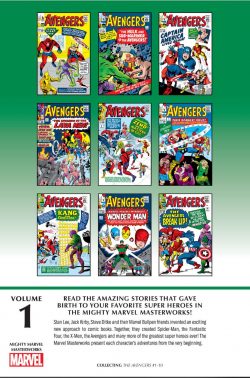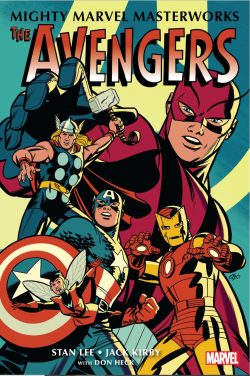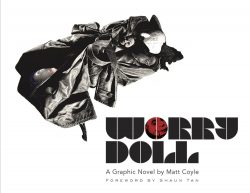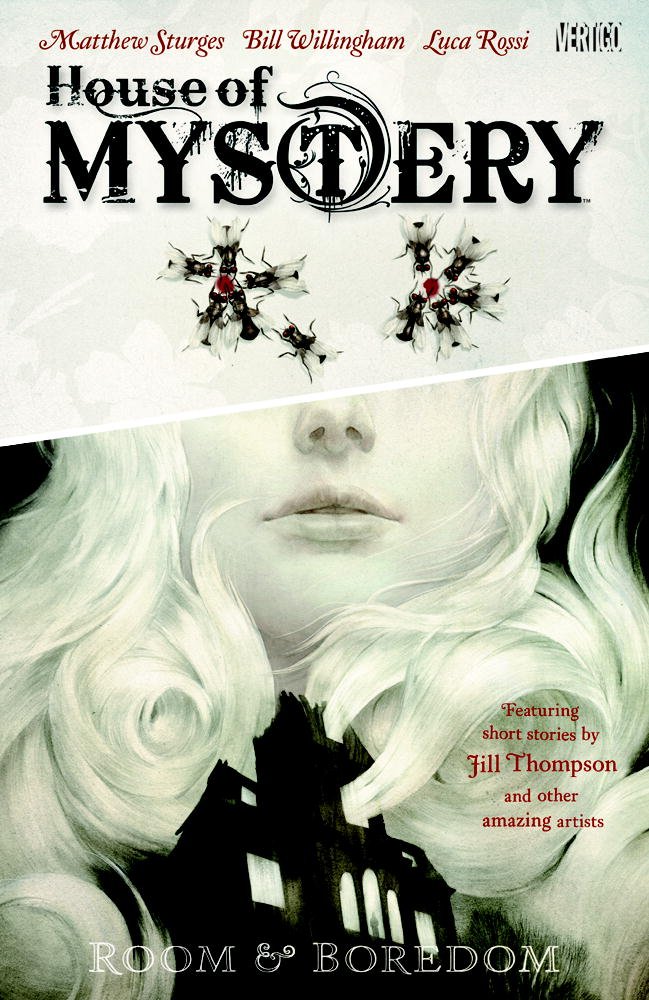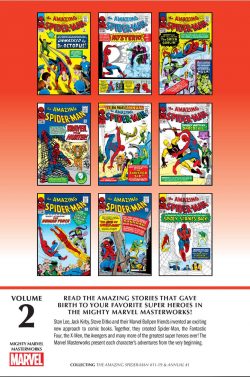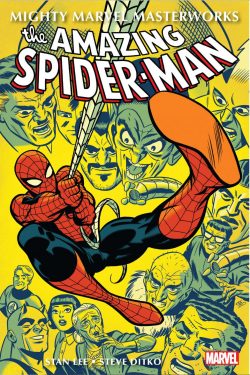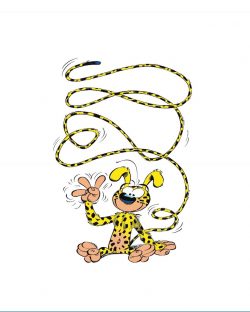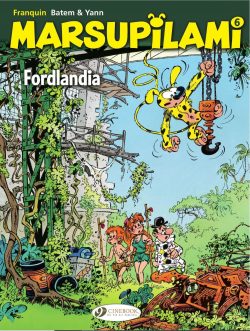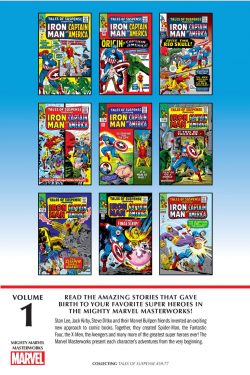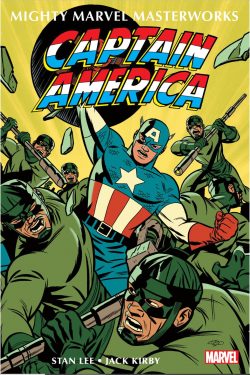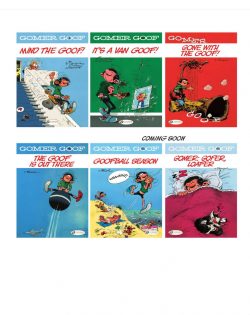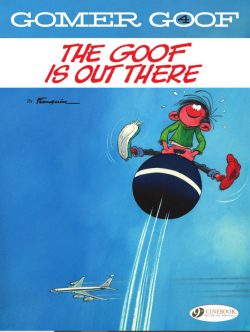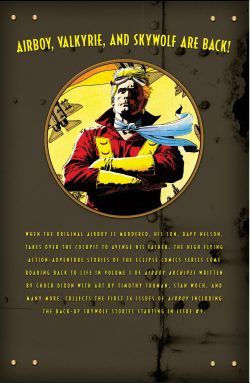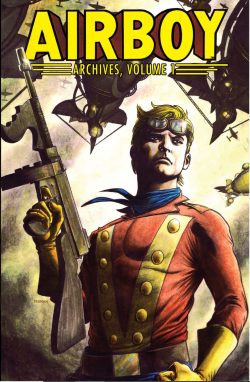
By Jamie Smart & with Sammy Borras (David Fickling Books)
ISBN: 978-1-78845-292-2 (Digest PB)
Bunny vs. Monkey has been a staple of The Phoenix from the first issue in 2012: detailing a madcap vendetta gripping animal archenemies amidst an idyllic arcadia masquerading as more-or-less mundane but critically endangered English woodlands.
Concocted with gleefully inspired mania by cartoonist and novelist Jamie Smart (Fish Head Steve!; Looshkin; Flember), these trendsetting, mindbending yarns have all the tail-biting tension and animal argy-bargy of a uniquely off-kilter magnum opus – not to be confused with the veritable magnificent octopus – although there’s them occasionally popping up too…
It all began yonks ago after an obnoxious little simian slapped down in the wake of a disastrous British space shot. Crashlanding in Crinkle Woods – scant miles from his launch site – lab animal Monkey believed himself the rightful inheritor of a strange new world, despite all efforts from reasonable, sensible, genteel, contemplative forest resident Bunny to dissuade him. For all his patience, propriety and good breeding, the laid-back lepine just could not contain the incorrigible idiot ape, who was – and is – a rude, noise-loving, chaos-creating loutish troublemaker…
Problems are ever-exacerbated by other unconventional Crinkle critters, particularly a skunk – AKA Skunky – who has a mad scientist’s attitude to life and a propensity to build extremely dangerous robots and overly technological super-weapons…
Here – with artistic assistance from design deputy Sammy Borras – the war of nerves and mega-ordnances is rekindled after briefly seeming to be all over. Our unruly assortment of odd bods cluttering up the bucolic paradise had finally picked sides and sorted it all out and – with battles ended – even apparently forgot the ever-encroaching Hyoomanz…
Rather than the traditional opening and tales ranked by changing seasons, this titanic trade paperback archive of insanity offers two massive chapters subdivided into short instalments. The astounding new adventure opens in Part One and ‘Pond Life’ wherein a quiet moment of skating in the chilly evening of a New Year is going so well until our apish antagonist renews old dreams of a planet united under his rule and the banner of “Monkeyopia”.
Sadly, the banner is attached to a staff with a really pointy end… and ice is really brittle…
An epoch of bewildering calamity commences when animal alternates from a parallel universe pop in through a portal. On their home plane everyone is evil but even so, their abduction of pan–universal innocent Pig Piggerton goes terribly wrong: stranding the instigator of the ‘Pig Swap’ on the wrong realm…
Meanwhile, Skunky has temporarily got rid of his annoying Monkey mate with some pointless make-work in ‘Snow Fun’ and ‘Evil Pig’ has introduced himself to the other Crinkle critters. Of course, Monkey must prove he’s the most wicked…
With Skunky, Monkey and the transplanted Pig all menacing and recruiting minions, confused Bunny calls on everyone to again ‘Choose Your Side’, but things get a bit out of hand when Metal Steve, Metal E.V.E. and brain-battered, bewildered former stuntman Action Beaver all join in the party games…
Thankfully, Eve allies with the good guys and Bunny affirms that their prime directive is “protecting the woods at all costs”: ‘A Mammoth Task’ made even harder once Skunky and Monkey unleash giant undergrounds monsters…
Dedicated to doom and destruction, the bad boys try – and ultimately fail – to synthesize Mongolian Death molluscs in ‘With Snails & I’ and try to pluck the ‘Big Moon’ out of the night sky before clashing with Evil Pig…
The transplanted transdimensional then meets his counterpart’s best bud Weenie Squirrel and has ‘A Falling Out’ even as Monkey unleashes exploding duplicates in ‘All A-Clone’ before trying his hand at scary documentary making in ‘The Sand-Witch Project’. All that cloning around comes back to bite him in the form of ‘Monkeysaurus’
Desperate for peace and quiet, Bunny, Eve and superfast Ai seek solace and silence in the river, but find only more mad excitement when evil spies get into difficulties and require their ‘Canoooe’, unaware that temporary allies Evil Pig, Skunky and Monkey were messing with serums and animals and had ‘Gone Batty’…
When Skunky tries to upgrade obsolete robotic oaf Metal Steve, reformed Eve is trapped in his bandwidth and is transformed into ‘Eve 2.0’, whilst Evil Pig – still seeking to win over Weenie – instead subverts Steve into ‘Alan the Unicorn’…
Existence gets truly meta when godlike human beings abruptly intervene, inadvertently sharing a glimpse behind the cosmic curtains of reality and by inflicting a distressing touch of The Matrix in ‘The First Glitch’ offers our quotidian cast of layered realities a hideous glimpse of what reality really means. Thoroughly re-educated, the bad guys then lose control of another experiment, unleashing shapeshifter ‘Polymorph’ on the easily embarrassed denizens of the Woods.
Fearless and stupid, Monkey discovers a sleeping beast and refuses to listen when everyone tells him ‘Don’t Wake the Bear’…
After too long and portentous an interval, the evil doppelgangers return, banishing their counterparts across many ‘Dimensions’ before ending the multiverse itself. Only Bunny escapes and with the unlikeliest of allies begins exploring ‘The Infinite’ and – thanks to a Portable Dimension Hopper – seeks ways to restore reality and rescue his comrades from the Real World.
That means many appalling experiences including ‘Babysitting’ toddler-versions of all his friends and foes, clashing with ghosts, vampires and Halloween Dimension beings before – as ‘Grumpy Bunny’ – saving a cowboy realm from the perils of a ‘Wilder West’. Bridging warring lava and frost dimensions ‘Of Fire and Ice’ that are also infested with familiar variants of everyone he knew, the thankless quest finally pays off in a commerce dimension ruled by an ‘Office Monkey’ only too glad to be rid of the annoying anarchic duplicate pestering his people and threatening his bottom line…
When the idiot ape eats Bunny’s travel tech, the status quo starts to resettle but by then the voyagers have found a dystopian desert where civilisation has gone ‘Mad to the Max’. Happily, Skunky is there to fix the gadget and get them on their way to the Christmas Dimension, and then out of the land of ‘Ho Ho Oh No’: so lovely that no one ever leaves…
The assembled animals ultimately prove that’s not true, but only at the cost of their ship which is badly hit, leaving them ‘Doomed’ to fall between 9.7 billion dimensions until they unselfishly work together in a team up. As a result they touch down at the Very End of Existence Itself! Stuck in a formless void, only Bunny and Skunky seem able to go on and use the lack of working time to recreate useful bits of what’s been eradicated. Once they rerun ‘The Birth of Science’ it’s not too long before they’re ready to fix everything and open a portal… sparking a massive time loop…
Forewarned by déjà vu, the voyagers overreact and reality goes boink! again, dumping everyone into the dimension of excrement and causing a nasty ‘Pooey Christmas’…
It looks like a fresh beginning for all as Part Two opens with ‘A New Start’. The nice animals are having picnics and Skunky and Monkey are building better mecha-weapons, but something’s still not quite right, and when the miscreants unleash transforming terror ‘Octoplops’ the repercussions really aren’t that bad…
Still off his game, cupcake-addicted Monkey is easily exposed as a ‘Thief!’ and Weenie and Pig endure the sheer horror of losing their ‘Ducky’ to a mystery fiend, before an escaped Time Droid goes berserk and generates a ‘Looooooop’ in reality…
Thanks to Transmogrification Pants, Bunny is assaulted by fake friends he never knew in ‘Pants for the Memories’ whilst Skunky, Monkey, the Beaver and Metal Steve are stuck inside their own malfunctioning ‘Chameleotron’: a chaotic debacle that results in Monkey being sucked back into the appalling ‘Poo Dimension’ where he accidentally liberates a fearsome alternate self who is a genuine threat to everyone in Crinkle Woods…
A brief dalliance as superhero ‘Brave Bunny’ quickly palls for our genteel star and ‘Law and Order’ is brutally abused when ultra-efficient Office Monkey begins to modernise and corporatize the green paradise…
Initially set back and hindered by the workforce he has to work with, OM retrenches and debuts his polluting ‘Furps’ engine (don’t ask and don’t breathe in!) before forming a merger with Skunky…
The other critters are all enjoying ‘Lobnut Day!’ and trying to gather the most nuts, but wise up when the apish alternate dimension asset-stripper launches Monkey Corp. and seeks to put all the furry time-wasters ‘To Work’. However, by casually betraying Skunky, Office Monkey has sown the seeds of his own downfall and his ‘Streamlining’ the Woods into a modernistic business park triggers a groundswell of consumer resistance…
After losing a contest and being acclaimed ‘The Worst Inventor’ Skunky joins that rebellion, and ‘Wrong Monkey’ finds him planning to dismantle the corporate stronghold of Monkeytopia, revealing to the astounded woodlanders that the menace is not the annoying idiot they’re used to, but an extradimensional invader…
That said, the mercurial monochrome megamind recruits some alternate selves with his Time-o-tron and he and ‘Father Skunky’ plunge into the vortex void to unmake their current dire situation…
Tragically, all that multiversal mismanagement causes a few ‘Portal Problems’ and an unwise stopover at their starting point (three in one book!) prompts an unexpected self-promotion as Office Monkey exploits the confusion to become Boss Level and ‘Takeover’ the universe…
Ejected from Reality, archnemesis Bunny is flung into the Poo Dimension where his usual enemy has become ‘King Monkey’. Implausibly, he has a plan to save the day and put everything back the way it was… more or less…
The narrative animal anarchy might have pawsed (not sorry!) for now but there’s more secrets to share thanks to detailed instructions on ‘‘How to Draw Cowboy Monkey!’, ‘How to Draw Hellcage Monkey!’ and ‘How to Draw Office Monkey!’ to wind down from all that angsty parallel peril and future-bending furore…
The zany zenith of absurdist adventure, Bunny vs Monkey is weird, wild wit, brilliantly bonkers invention, potent sentiment and superb cartooning all crammed into one eccentrically excellent package. These tails never fail to deliver jubilant joy for grown-ups of every vintage, even those who claim they only get it for their kids. This is the kind of comic parents beg kids to read to them. Shouldn’t that be you?
Text and illustrations © Jamie Smart 2023. All rights reserved.

